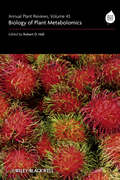
INDICE: Contributors. Preface. Acknowledgements. 1 Plant Metabolomics in a Nutshell: Potential and Future Challenges (Robert D. Hall). 1.1 The history and the goals of plant metabolomics. 1.2 The technologies. 1.3 The applications.1.4 The bottlenecks, the potential and future challenges. 2 Metabolite Analysis and Metabolomics in the Study of Biotrophic Interactions between Plants andMicrobes (John Draper, Susanne Rasmussen and Hassan Zubair). 2.1 Introduction. 2.2 Biotrophic phases of interactions between fungal pathogens and plant hosts. 2.3 Mutualistic plant associations with endosymbionts. 2.4 Conclusions, horizon scanning omics and physiological data. 3.7 How can technological improvements assist in data interpretation? 3.8 Where do we go from here? 4 A Role for Metabolomics in Plant Ecology (Nicole M. van Dam and Eddy van der Meijden). 4.1 A plant is never alone. 4.2 Applying metabolomics to wild plant species: yes we can! 4.3 Plant metabolomics and chemical ecology of plantinsect interactions: some success stories. 4.4 Plant metabolomics helps to advance theories in plant insect interactions. 4.5 Metabolomics for plant ecology in the future:possibilities and pitfalls. 5 Metabolomics of a Model Fruit: Tomato (Ric C.H.de Vos, Robert D. Hall and Annick Moing). 5.1 Introduction. 5.2 A few key examples of the broad relevance of tomato fruit metabolomics. 5.3 Predictions forthe future. 5.4 Conclusions. 6 Metabolomics of Arabidopsis thaliana (Michael H. Beale and Michael R. Sussman). 6.1 Introduction. 6.2 The Arabidopsis metabolome. 6.3 Measuring the Arabidopsis metabolome. 6.4 Metabolomics and Arabidopsis molecular plant physiology. 6.5 Metabolomics in Arabidopsis functional genomics. 6.6 Genetical metabolomics. 6.7 Forward look. 7 Crops and Tasty, Nutritious Food How Can Metabolomics Help? (Derek Stewart, Louise V.T. Shepherd, Robert D. Hall and Paul D. Fraser). 7.1 Every food chain begins with plants. 7.2 Potato and tomato both fresh and processed. 7.3 Grain crops. 7.4 Soft fruit metabolomics. 7.5 Metabolomics and our most important beverages coffee, tea and wine. 7.6 Food product contamination and adulteration. 7.7 Metabolite profilingtechnologies used to evaluate crop safety. 7.8 The future importance of metabolomics in crop research. 8 Genetics, Genomics and Metabolomics (Alisdair R. Fernie and Joost J.B. Keurentjes). 8.1 Introduction. 8.2 Genetic understanding of metabolism in the pre-genomics era. 8.3 Genetic analysis of natural variance in plants RILs and NILs. 8.4 Analysis of crop natural variance and broad genetic populations. 8.5 Linking genotypic and phenotypic diversity. 8.6 Finding the mechanisms underlying the QTL. 8.7 Integration of omic data with physiological traits. 8.8 Metabolomics aiding the understanding of quantitative genetics. 8.9 Perspective of metabolomics assisted breeding. 8.10 Concluding remarks and perspect
- ISBN: 978-1-4051-9954-4
- Editorial: Wiley-Blackwell
- Encuadernacion: Cartoné
- Páginas: 448
- Fecha Publicación: 01/04/2011
- Nº Volúmenes: 1
- Idioma: Inglés
